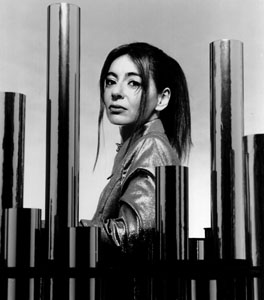![[Metroactive Music]](/music/gifs/music468.gif)
[ Music Index | Santa Cruz Week | SantaCruz Home | Archives ]
A Rousing Sound
Cabrillo Music Festival surprises, thrills with program of innovative composer
By Scott MacClelland
WITH THE ARDENT advocacy of Cabrillo Festival of Contemporary Music conductor Marin Alsop, Christopher Rouse has emerged unequivocally as a leading American composer in the post-minimalist era. His generous parade of symphonic works exhibits clear vision, brilliant craft and stylistic individuality.
The most surprising work in an all-Rouse program at this year's festival was the symphonic songbook, Kabir Padavali, based on verses by the 15th-century Indian poet. A veritable treasury of ideas and instrumental colors, this is nothing less than an orchestral tour de force, impulsive, intimate, explosive, imaginative and supremely confident. With similar authority, soprano Valdine Anderson became the poet, infusing the words with a range of expression that matched the orchestral effects.
The evening also heard excellent readings of his three-movement Phatasmata, Envoi, a lengthy mediation on the death of his mother, and Phaeton, a high-speed kaleidoscopic flight that deserves entry in the Guinness Book of Records for packing more notes per minute than any other musical work in history.
The amazing Evelyn Glennie is a once-in-a-lifetime virtuoso of blinding speed and accuracy, breathtaking impulse and unquenchable personality. She presides over a zoological park of instruments that includes at least a dozen hitherto unknown species. Composer Michael Daugherty's UFO (a Star Trek fantasy, as he described it) featured the petite percussionist from Scotland who is famously deaf and performs in bare feet. Despite all of Daugherty's sensational orchestral glitz, it was Glennie who stole the show, provoking first a gasp of disbelief from the audience, then a standing ovation. The evening opened with Daugherty's 10-minute run from Chicago to Los Angeles on "Route 66," a congestion of vernacular Americana deliciously twisted into symphonic brilliance. Between the two works, Alsop and her "dream" orchestra delivered The Four Sections, a 1987 classic of minimalism by Steve Reich, showing, for him, a unusually colorful orchestral palette.
'Women' on the Verge
Unlike most recent American operas, which have gotten a "yes, but ... " reaction from critics and the public, Mark Adamo's Little Women seems to have inspired more enthusiasm. Since its premiere in 1998 it has attracted at least 13 productions--not bad for an opera that offers no particular action and makes its argument on the basis of polite relationships and generally veiled emotions.
At the festival, Alsop kept the work in motion, despite a dramatic inertia that slows the first act to a crawl. Adamo redeems himself in Act 2, however, where the pace picks up and successfully pushes the action to resolution. Production values and stage direction were spare, but effective at keeping focus on the characters and music.
Adamo's libretto magnifies the character of Jo and her tortuous path to love. Cherry Duke carried the daunting role with dignity and, whenever possible, intensity. However, she, like many in the cast, swallowed consonants often to the point of unintelligibility. (No supertitles were available.) On the other hand, John Packard, as John Brooke, placed the voice forward, leaving no word unclear, and what a welcome difference that made.
Adamo's opera alternates smartly between narrative, ensembles and arias, with, as Alex Ross in The New Yorker put it, "... three dollops of tonality and two pinches of dissonance." Most memorable of the solo scenes were Jo's "Perfect As We Are" in Act 1 and the baritone "love" aria of Act 2, sung by Kurt Ollmann. Although Adamo has yet to establish his own unmistakable fingerprints, or even suggest any startling musical vision, his first opera certainly demonstrates plenty of craft and no little talent to drive it.
The festival finale at San Juan Bautista spotlighted West Coast premieres by Daugherty and John Corigliano, sandwiching a 1994 marimba concerto by venerable Scottish composer Thea Musgrave. Daugherty completed Bells for Stokowski last year on a commission to celebrate the innovative, flamboyant conductor of the Philadelphia Orchestra from 1912 through 1936. Accordingly, Daugherty echoes all of Stokowski's slick effects, not least "Stokie's" notorious arrangements of Bach organ works. Musgrave's Journey Through a Japanese Landscape scans the four seasons, from spring's rustling grasses to winter's icy tingles, through a range of percussion, especially the marimba, featuring the irrepressible Glennie. The orchestral palette, while often bold, massages the ear with subtleties as well, like the greens of a Japanese garden. Corigliano's Symphony no. 2 for strings, lasting 40 minutes, decorates traditional forms with the rich sonorities and suspended dissonances pioneered by Corelli 300 years ago. Unlike Corelli, however, Corigliano slides though quarter tones in pursuit of resolutions.
The work's five-movement arch form recalls Bartok's Concerto for Orchestra and fourth string quartet.
Copyright © Metro Publishing Inc. Maintained by Boulevards New Media.
![]()

Barefoot and Poignant: Evelyn Glennie knocked the socks off the Cabrillo Music Festival audience.
From the August 14-21, 2002 issue of Metro Santa Cruz.